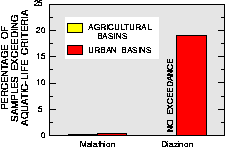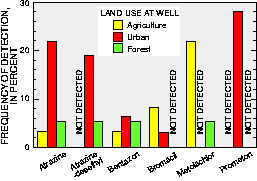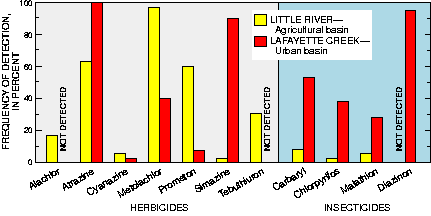Pesticide concentrations in streams and ground water did not exceed USEPA drinking-water standards; however, concentrations of two insecticides--diazinon and malathion--sometimes exceeded aquatic-life criteria (Gilliom and others, in press). The exceedances for these insecticides occurred more frequently in samples from an urban stream in Tallahassee than in samples from three streams draining agricultural basins in central Georgia. Not all of the pesticides analyzed in samples have been assigned drinking-water standards or aquatic-life criteria (p. 24-25).

About 20 percent of diazinon concentrations in a stream draining an urban basin exceeded the aquatic-life criteria.
 (256,823 bytes)
(256,823 bytes)
Photo by D.N. Skofronick, Tallahassee, Fla.
Of 85 pesticides (including herbicides, insecticides, and degradation products) analyzed, 20 herbicides and two insecticide degradation products were detected in 114 ground water samples. The median concentration for all herbicide analyses combined was 0.03 microgram per liter (µg/L), 95 percent of the concentrations were less than 1.04 µg/L. Pesticides with the highest concentrations were bromacil and bentazon. Bromacil concentrations of 57 and 14 µg/L were detected in a ground-water seepage study in a citrus-growing area in central Florida (p. 22). Bromacil is used for weed control in citrus and noncropland areas. Bentazon (maximum concentration of 6.4 µg/L) controls broadleaf weeds in corn, peanuts, and beans.
Twenty-two herbicides, 7 insecticides, and 3 degradation products were detected in 209 water samples collected from three streams draining agricultural basins (Hatzell, 1997) and one stream draining an urban basin. The median concentration for all pesticide analyses combined was 0.012 µg/L, which is about one-third of the ground-water median. Ninety-five percent of all pesticide detections in surface water were less than 0.12 µg/L. The highest pesticide concentrations were 2.62 µg/L of propargite and 0.86 µg/L of atrazine. Propargite, which is used to control mites in orchards, was only detected twice. Atrazine, a herbicide used to control a variety of weeds in corn and sorghum, was the most frequently detected pesticide in surface water.
When comparing pesticides in ground water with those in surface water, it should be noted that different sampling strategies were used (p. 22-23). Ground water was sampled at many wells over a large area, with usually one or two samples from each well. Surface water was usually intensively sampled at a few sites for 3 years. Thus, ground-water samples generally provided more spatial information about the distribution of pesticides, whereas surface-water samples generally provided more temporal information.
Metolachlor, used to control weeds in a wide variety of crops, was the most frequently detected herbicide. Atrazine, bentazon, and 11 other herbicides were also detected in ground water within agricultural areas; however, each of these pesticides was detected in less than 5 percent of the samples. Samples from seven wells contained three or more herbicides per sample.

Atrazine, metolachlor, and prometon were the herbicides detected most frequently in ground water.
Atrazine and metolachlor were among the most frequently detected pesticides in streams draining agricultural basins.
Insecticides were detected in less than 30 percent of the samples from three streams draining agricultural basins. In contrast, five herbicides were detected in more than 30 percent of the samples from at least one of the streams.
Comparisons among the three streams indicate that several streams would need to be intensively sampled to provide an overview of the pesticides detected in streams draining agricultural basins. For example, although most pesticides were detected in all three streams, prometon would not have been detected if Tucsawhatchee Creek had been the only agricultural stream sampled. Herbicides applied to cotton, such as diuron, fluometuron, and norflurazon, were detected only in Tucsawhatchee Creek which has about one-third of the basin planted in cotton compared to about one-fifth for the other two basins. Generally, the largest number of different pesticides detected was in Tucsawhatchee Creek, and the highest percentage of detections for insecticides was in the Withlacoochee River.
A ground-water study in a row-crop agricultural area was done in the northernmost part of the Suwannee River Basin, which contains the Little River, an intensively sampled stream. This overlap provided an opportunity to examine pesticides present in ground water and stream water in one area over the same time periods (March-April and August, 1994). During the two sampling periods, nine herbicides and one insecticide degradation product were detected in ground water whereas five herbicides, one herbicide degradation product, and one insecticide were detected in stream water.
Only metolachlor and atrazine were present in both ground water and stream samples. Metolachlor was detected in nearly 40 percent of the wells sampled in March-April and about 20 percent of the wells sampled in August, whereas atrazine was detected once in March-April. Metolachlor and atrazine were detected in all of the stream samples.
Pesticide detections from the ground water row-crop agricultural study were compared to pesticide detections from stream samples from the Little River Basin.
More pesticides were detected in ground water and stream water in March-April than in August. The March-April period occurs at the beginning of the planting season when herbicides are frequently applied before or shortly after planting. Three herbicides used to control weeds in cotton--diuron, fluometuron, and norflurazon--were detected in ground-water samples. Two of the herbicides detected in stream water--prometon and tebuthiuron--are used to control weeds in noncropland areas. Ethoprop, which is used to control nematodes, was detected in a stream sample taken in March-April.
Herbicides that were detected in urban areas but not agricultural areas included cyanazine, fenuron, and prometon. The occurrence of cyanazine in an urban area was not expected because cyanazine is usually applied to control weeds in field corn. Fenuron is used to control woody plants and perennial weeds. Prometon is a nonselective herbicide used to control many grasses and broadleaf weeds. Five herbicides--atrazine, bromacil, bentazon, simazine, and tebuthiuron--were detected in ground water in both urban and agricultural areas.
Differences in herbicide detections in ground water were also present when two urban areas, Ocala and Tampa, Fla., were compared. These results are somewhat surprising because these two cities are only about 150 miles apart, and landscaping and pest management practices are likely similar. Most of the detections for prometon and atrazine in urban areas were in Ocala. Six additional herbicides were detected in one of the two cities. Some of the differences could be attributed to the type of urban land use adjacent to the wells. The wells in Ocala were in downtown parks and near schools, whereas the wells in Tampa were in a residential section.
The primary difference between Lafayette Creek, which drains an urban basin, and the Little River, which drains an agricultural basin, was the greater frequency of insecticide detections in Lafayette Creek. Other differences included greater frequencies of atrazine and simazine detections, as well as an absence of alachlor and tebuthiuron detections in Lafayette Creek.

Four insecticides were detected in more than 25 percent of the samples from a stream draining an urban basin.
When all detections for each month were counted regardless of the year of occurrence, an interesting contrast became apparent between Lafayette Creek (urban basin) and the Little River (agricultural basin). In the Little River, the frequency of detections for herbicides and insecticides generally followed the planting and harvesting seasons for the major crops. The frequency decreased in the fallow season, when agricultural activity is at a minimum and many fields are unplanted. Also, the frequency of detections of herbicides was always higher than that for insecticides.
The frequency of pesticide detections in a stream draining an agricultural basin was related to the agricultural cycle.
In contrast, herbicide and insecticide detections in Lafayette Creek did not follow the cyclic pattern of agriculture. From June through August, the frequency of insecticide detections in Lafayette Creek was about equal to the frequency of herbicide detections.
Atrazine, bentazon, metolachlor, or p,p´-DDE (a degradation product of DDT) were detected at least once in samples from four wells in forest areas. These detections were unexpected and could be related to several conditions: pesticide applications during previous land uses of the currently forested area, land uses upgradient from the wells, or improper disposal of pesticides.
Last modified: April 14, 1998 10:45 am